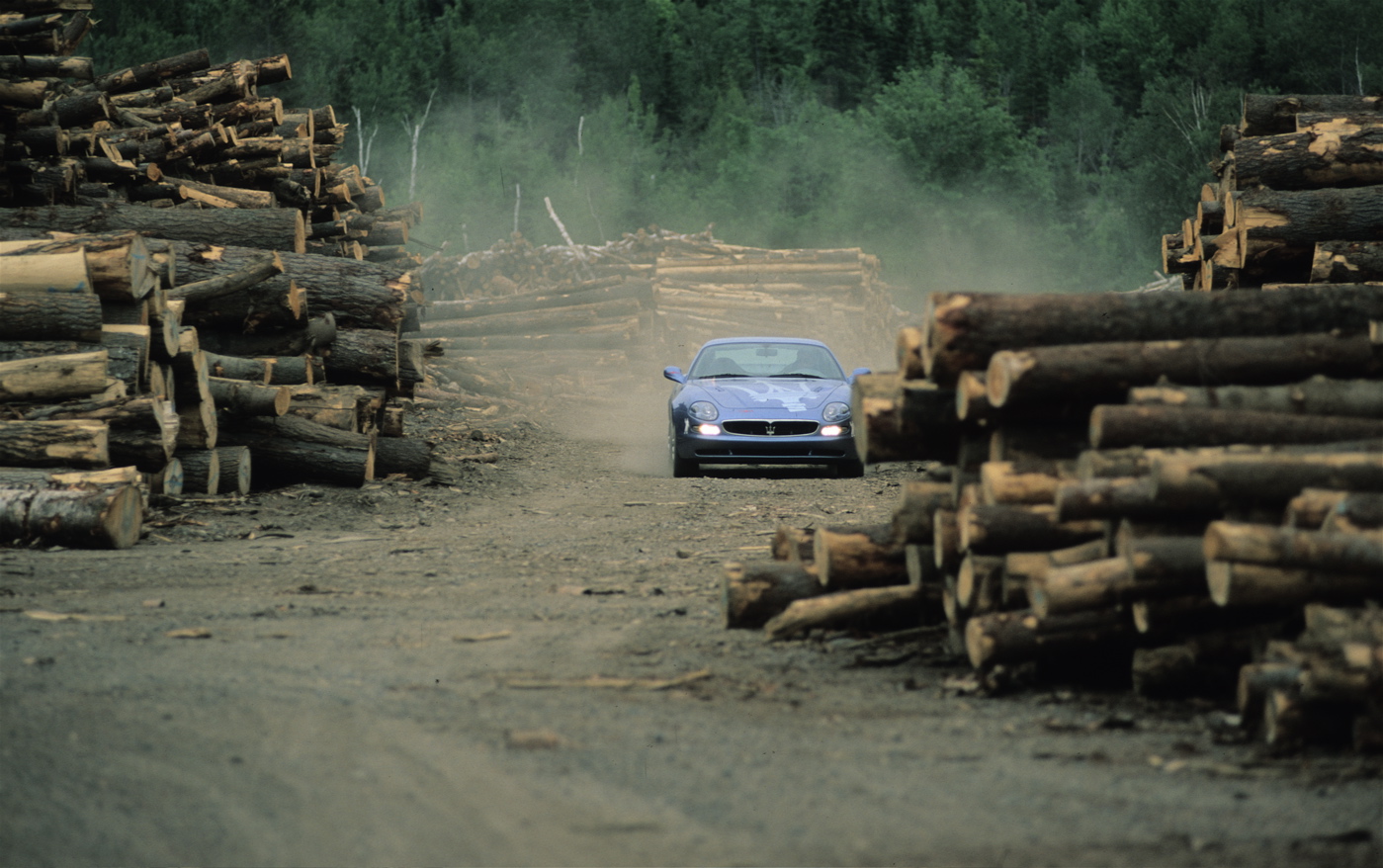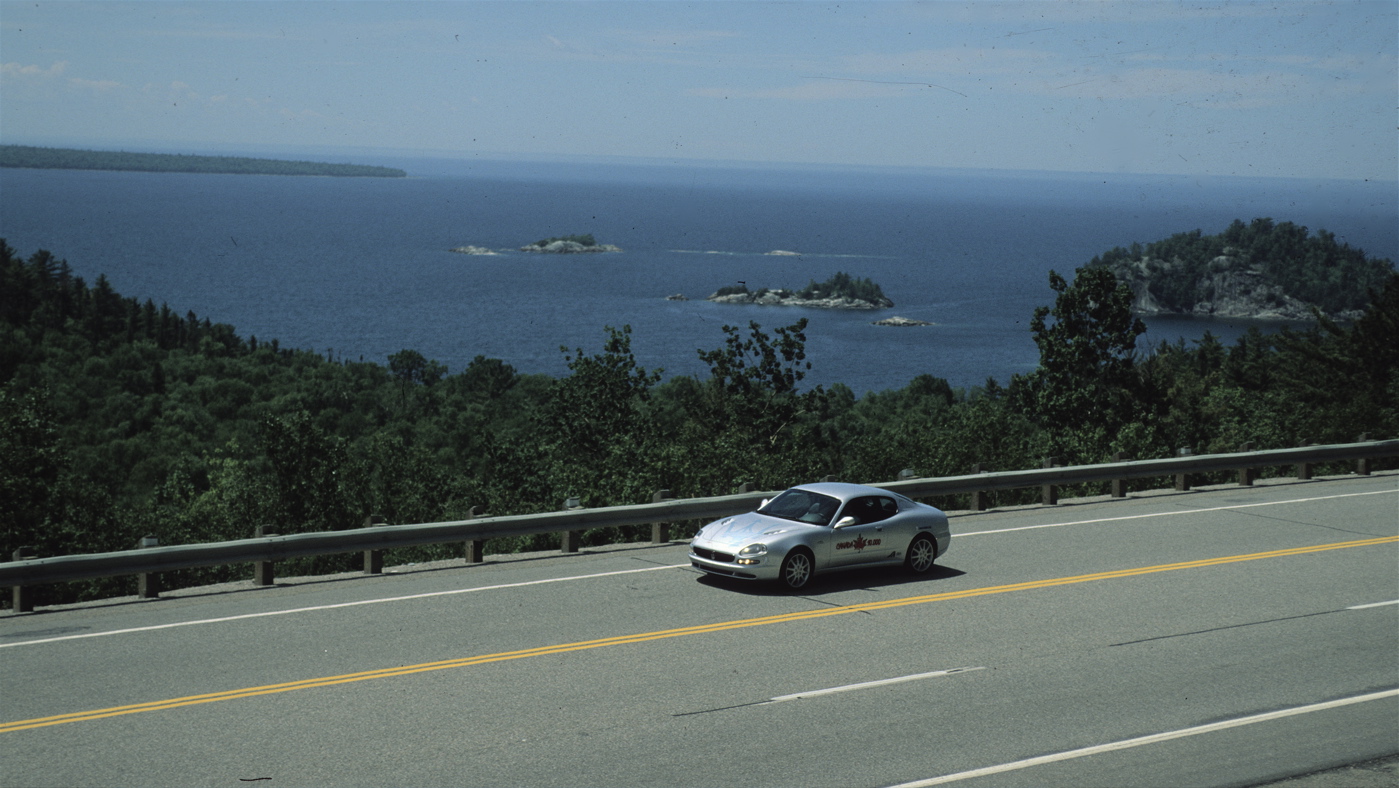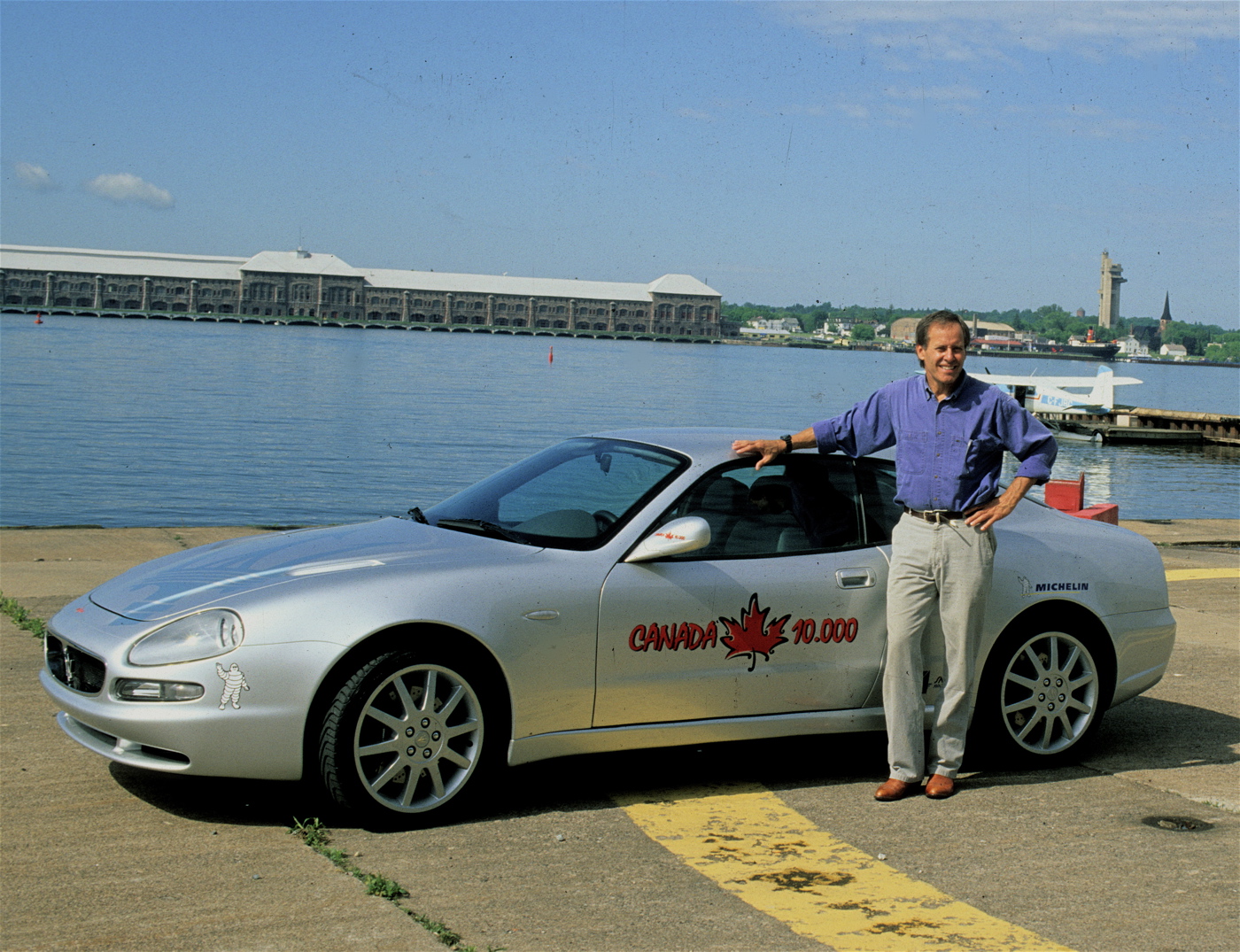Ontario, Canada: Maserati 3200GT
Bending Speed Limit, Ontario
“I might not have nine lives but, buckled into the Maserati, I definately have six.”
Champlain Park, Mattawa
Hgwy 17, Lake Huron, Ontario
“Revving it from idle to the rev limiter, causes the engine note to rise from a silky growl, to an authoritative bellow…”
“So how do you drive a 365 horsepower, six speed, blindingly fast 2+2 coupe for 2500 miles across Ontario without exceeding 75 mph?”
Old Fort Henry, Kingston
“Located on the St. Lawrence Seaway, Kingston’s Old Fort Henry was built to protect Canada against incursions from it’s avaricious southern neighbor.”
“I realized that driving the Maserati transforms anyone into a celebrity.”
Railroad Sault Ste-Marie
“Ontario’s natural beauty and rich history seduced us and with each stop we fell further behind.”
Sawmill, Maserati Abused
“…that night in Winnipeg, at the historic Fort Garry Hotel, I felt a profound sense of loss when I handed the keys back to Massimo.”
I have no doubt that Maserati’s twin turbo 3200 GT will do every bit of a claimed 172 miles per hour. In fact, the only thing keeping me from testing the GT’s published top end is Canada’s 75 mph legal speed limit. The Ontario Provincial Police (OPP) not only outlawed radar detectors, but locals swear Canada’s Finest know when they are being scanned. Ontario’s posted $500 fine for 130 kilometers doubles for 200, then doubles again for 230. If 142mph is worth $4000 then 276.807 rates a month in the slammer. How the OPP are able to detect radar detectors is unclear, but my co-pilot, Signore Franco Verschuren knows half a dozen people who were pulled over and cited for using Whistlers, Passports, Unidens or whatever else happened to be the detector di giorno.
Designed by Giorgetto Giugiaro, the 3200GT is a front-engine, rear-wheel-drive, 2+2-passenger, 2-door coupe with a list price in the neighborhood of $80,000. From it’s rounded front end, vented hood and flared front fenders that flow back to a sculpted rear deck and gorgeous brake light package, the Maserati projects a predatory profile. Settling into the six way adjustable leather seat, while my right hand caresses the six speed gear shift and my foot toes the throttle, I savor a powerful jolt of testosterone. I might not have nine lives but, buckled into the Maserati, I definately have six.
First Nation's Museum, ONTARIO
For these reasons, I am not intimidated by the OPP, their offshore Chevrolets, or thick citation books. I am not deterred by high speeds, can control a four wheel drift with throttle alone, can power shift without blowing the clutch or engine, am a fair mechanic, don’t smoke and limit myself to a glass of red wine with dinner. Though I speak rusty Italian, I can pronounce “Maserati” like a native son and would prefer to write this story in that lingua romantica.
Maserati’s introduction of its 3200 GT Coupe to North America was a bella piece of marketing. Starting in Montreal, Quebec on June 12, and concluding in Inuvik, Northwest Territories above the Arctic Circle on July 14, twenty international journalists and photographers were invited to trace the route of the 18th Century French Vogageurs–the trappers and traders that ultimately traversed Canada and much of the northern United States.
Among the journalists were an Italian documentary film crew, Luca, Paulo, Gabriela and Manlieo. Angelo the Maserati mechanic served as insurance against unforseen and unanticipated mechanical glitches while Massimo Guaraldi, Maserati’s Technical Inspector was responsible for the cars and helped coordinate the schedule.
Scheduled to cover 10,000 kilometers, or roughly 6000 miles, the introduction doubled as an endurance test–a chance to prove that the Trident Marque had solved the reliability, emissions and design flaws that had preceded its much lamented withdrawal from North America nearly 20 years ago.
Until the 3200 GT growled to a stop in front of Ottawa’s historic sandstone and copper roofed Parliament Buildings, I had no idea what one looked like. Repeated attempts to download a photo off the internet resulted in long waits followed by pages of numbers. I assumed the test cars would be red, or at least yellow but the blue and silver was understated to the point of camouflage.
Before turning me loose with an advertised 365 horsepower (actually 375 but for marketing reasons Maserati understates the number) Massimo Guaraldi gave me an orientation ride along Ottawa’s beautiful Rideau Canal. In lightly accented English, Guaraldi described how the 3200GT’s chassis is composed of a sheet steel bearing body from which a front tubular frame supports the engine assembly and a deformable double wishbone suspension with forged aluminum links . A second tubular frame supports differential and the rear suspension system while rigid integral joints at both front and rear help reduce unsuspended mass.
For brakes, the 3200 has four oversized (330 x 32 mm at front, 310 x 28 mm at rear), ventilated discs with duct cooling on the front discs. Driven by a four-channel ABS with split cross-over braking circuit, the 3200 also incorporates a software controlled brake force distributor that delivers close to 100% braking efficiency when the deceleration force exceeds 0.45 g. In short, the 3200 offers incredible handling and braking. High speeds (read over 150 mph) sweeping turns, tight corners or cobble stone city streets, the coupe exhibits impeccable manners. But then you’d expect a Maserati to handle. It’s the engine that takes you by surprise.
Air Museum, Sault St. Marie
Triggered by a “Drive-by-Wire” Magneti Marelli electronic management system that controls both fuel injection and ignition and balanced to within .02 grams, the 3217cc twin-turbocharged and intercooled DOHC32-valve aluminum V-8 pumps out 365 bhp @ 6250 rpm. To put that in layman’s terms, the 362 lb-ft @ 4500 rpm torque curve simply slams you into the molded leather seats. Coupled to a curb weight of 3500 lb the 3200GT acclerates from zero to 62 mph in 5.1 seconds. Revving it from idle to the rev limiter, causes the engine note to rise from a silky growl, to an authoritative bellow as the twin turbos kick in and the beautiful V-8 begins to produce visceral handfuls of horse power in hard, serious surges.
Implicit in engineer Guaraldi’s final instructions were, “Have fun, but don’t WAD this Maserati.”
So how do you drive a 365 horsepower, six speed, blindingly fast 2+2 coupe for 2500 miles across Ontario without exceeding 75 mph? Even the Archbishop of Ottawa would be tempted. And, if he wasn’t then the lawmakers on Ottawa’s historic Parliament Hill would be.
To fully appreciate the 3200, you must know something of its history. Maserati owes it name and style to seven Maserati brothers who were born between 1881 and 1898. The first Maserati was built by Carlo, the eldest, and consisted of a single cylinder engine on a simple chassis. Brother Alfieri Maserati started Officine Alfieri Maserati in 1914, where the brothers subsequently focused their car building and racing energies. The Tipo 26, which featured a 1.5 liter supercharged inline 8, premiered on April 25, 1926, at the Targa Florio and was the first race car to bear the Maserati Trident. Taken from Giambologna’s Neptune, the Trident emblem was designed by Mario Maserati and proved to be a fortuitous and lasting choice.
Following Alfieri’s death in a racing accident, Maseratis were designed, built and raced by brother Ernesto from 1932 till 1939. After winning the Indianapolis 500 twice, once with Wilbur Shaw driving, Maserati was absorbed into Orsi Group in 1938-1939 and moved to Modena, where it continues production today.
In the years following the war, Stirling Moss and Jaun Manuel Fangio drove for Maserati with Fangio winning the 1957 F-1 World Championship in a 250 F. At roughly the same time Maserati was shifting its emphasis from racing to touring cars. From 1957-64 the company produced the 3500 GT Touring Coupe’ which was followed by a succession of now classic models including, the Quattroporte from 1963-69, the Mistral 1963-70, the elegant Ghibili 1966-73 and a series of other models that indelibly established the name Maserati as a maker of beautiful, extremely fast touring cars.
The ‘70’s oil crises, severely impacted Maserati’s sales. Following a series of strategic alliances with Citroen in 1968, Alejandro De Thomaso in 1976 and Chrysler in 1984 Maserati was subsequently purchased by Fiat Auto in 1993 which then sold half of the company to Ferrari in June of 1997. The few Italian patriarch’s who could still remember 1930’s epic duals between the two racing Marque’s, may have lamented the deal, but youthful pragmatists readily admitted that better Ferrari, than an automaker intent only on using the brand for a short lived marketing pop.
Ferrari first gutted then completely modernized Maserati’s historic 43,500 square meter factory on Viale Ciro Menotti in Modena, Italy. From computer aided design systems, engineering foundry work, assembly and outfitting, all manufacturing is completed on site with 60% of production slated for export and 40% to the home market.
OLD FORT HENRY, KINGSTON
As one of 20 journalists, I was scheduled to drive the Ontario leg, from Ottawa to Kingston, to Toronto and Niagara Falls, before turning northwest to Mattawa, Sault-Ste-Marie, Thunder Bay and finally to Winnipeg.
Departing by way of Ottawa’s Chateau Laurier Hotel and the National Gallery our route turned southeast on Highway 416 to Kingston. Located on the St. Lawrence Seaway, Kingston’s Old Fort Henry was built to protect Canada against incursions from it’s avaricious southern neighbor. The fort never fired a shot in anger and now serves as a historical footnote for Canadians and Americans who come for the dinner cruises that circle the St Lawrence Seaway.
OLD FORT HENRY, KINGSTON
The next morning we acclerated onto Highway 401 south to Toronto. Surrounded by commute traffic I realized that driving the Maserati transforms anyone into a celebrity. Holding a legal 65 miles per hour allowed construction workers in rusted out pickups, and blue suited businessmen in new Cadillacs, to keep pace, to wave, flash thumbs up or just as often roll down their windows and yell, “How fast will it go?”
Toronto welcomed us with a vibrant downtown nightlife and a morning tour of the Toronto Tower, before we continued south to Niagara Falls. Maserati asked for film of the 3200 GT’s driving above the falls and with Paulo the cameraman hanging out the open door, Ruedi Hafen, owner pilot of Niagara Helicopters chased the two coupes past the thundering cataracts.
From Niagara west, the distances increased. Stops for photo ops of the Maserati’s sliding sideways through sawmills and parked in front of curio shops, added to an already long day and by the time we reached Mattawa outside of North Bay, we had covered 500 miles in 11 hours. A welcoming party of Voyageurs in a large cargo canoe from the Canadian Ecology Center greeted the two Coupes , and after exploring the woods on ATVs and an excellent dinner on the Timber Train, we were shown to the Center’s individual forest cabins, where cool air and the sounds of loons marked the night.
The road from North Bay through Sturgeon Falls to Sault Ste. Marie has to be one of the most beautiful in Canada. Following lunch at Sudbury’s fascinating Science North Dinosaur exhibition we traced Highway 17 above Lake Huron where it twisted and turned across wooded points then straightened along the rocky shore. On a clear summer day, it brought out the 3200 GT’s best, the Coupe’s stunning acceleration, solid cornering and g force braking.
Ontario’s natural beauty and rich history seduced us and with each stop we fell further behind. It was only by sorely abusing the posted 120 km speed limit that were we able reach Thunder Bay by late evening. Morning rose over the historic Fort William Fur Trading Post where costumed actors, in character, inquired after our journey, our portages and trade goods. And I realized that driving twelve hour days in a 2000 Maserati was a luxury compared to the trials of original Voyageurs.
On this, my last day we were making time on Highway 71 just outside of Abkokan, when an OPP Black and White stopped the blue Maserati for 135km in 90km zone. Driven by Spanish journalists who at best spoke, no English, the scene verged on comical with the Opp officer asking, “Do you know how fast you were going.”
“No hablo Engles” the Spaniard shrugged, giving the impression he could care less about Highway 71’s 65 mph speed limit.
Manlieo’s explanation of the Canada 10,000 tour smoothed ruffled feathers. “Now slow down and don’t get me in trouble for letting you go,” the OPP officer reluctantly folded his citation book.
The last we saw of Canada’s finest he was holding a press kit, perplexedly watching us disappear over the nearest hill. Joining Transcananda 1 east of Kenora, Ontario, we accelerated west toward Winnipeg. As had happened dozens of times before, a truck with two working men pull alongside, rolled down the window and yelled, “So how fast will that go?”
That is the question. And the answer. Between Kenora and Winnipeg, there is an, empty, limited access stretch of road where the 3200 GT begged to be tested. With Massimo serving as a decoy three miles ahead, I put my foot to the floor and held it there. The 160,000 rpm turbos kicked in and the speedometer soared to a rarified, unbelievable number as trees and highway markers melted into a homogenized, blue green blur. How fast? In the neighborhood of 175–well beyond the point where OPP would have thrown me in jail. Faster than I’ve ever driven, faster than I’ve flown in a private plane. Fast enough to make realize that the 3200GT will do every bit of 190 and perhaps more.
Andrew Slough & 3200GT
And that night in Winnipeg, at the historic Fort Garry Hotel, I felt a profound sense of loss when I handed the keys back to Massimo. During that week, I had driven the 3200GT 2500 miles down some of Canada’s most beautiful roads. From Winnipeg the Canada 10,000 would continue to Vancouver where the caravan would turn north 2000 km on beat to hell gravel to Inuvik. From Coast to Coast the 3200GT’s would burn 3,300 liters of gas and cross eight Canadian provinces. The journalists would receive 2 speeding tickets and take 2000 photos. And, aside from a chipped windshield and an intercooler that was holed by a rock, the blue and silver Coupes performed flawlessly.
Perhaps Stirling Moss, who raced Maseratis in the 1950s and ’60s, said it best. After testing the first 3200GT to roll off the production line he said . “I only know about cars and women………..and I can’t see one thing bad about this car.”



